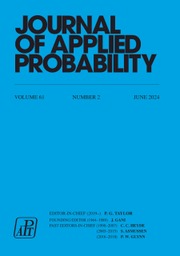Article contents
Limit of the Transport Capacity of a Dense Wireless Network
Part of:
Miscellaneous applications of functional analysis
Geometric probability and stochastic geometry
Miscellaneous applications of operator theory
Published online by Cambridge University Press: 14 July 2016
Abstract
Core share and HTML view are not available for this content. However, as you have access to this content, a full PDF is available via the ‘Save PDF’ action button.
It is known that the transport capacity of a dense wireless ad hoc network with n nodes scales like √n. We show that the transport capacity divided by √n approaches a nonrandom limit with probability 1 when the nodes are uniformly distributed on the unit square. To show the existence of the limit, we prove that the transport capacity under the protocol model is a subadditive Euclidean functional and use the machinery of subadditive functions in the spirit of Steele.
- Type
- Research Article
- Information
- Copyright
- Copyright © Applied Probability Trust 2010
References
[1]
Franceschetti, M., Dousse, O., Tse, D. N. C. and Thiran, P. (2007). {Closing the gap in the capacity of wireless networks via percolation theory}. IEEE Trans. Inf. Theory
53, 1009–1018.CrossRefGoogle Scholar
[2]
Ganti, R. K. and Haenggi, M. (2008). The transport capacity of a wireless network is a subadditive Euclidean functional. In Proc. IEEE Trans. Conf. Mobile Ad Hoc and Sensor Systems (Atlanta, GA), pp. 784–789.CrossRefGoogle Scholar
[3]
Gupta, P. and Kumar, P. R. (2000). {The capacity of wireless networks}. IEEE Trans. Inf. Theory
46, 388–404.CrossRefGoogle Scholar
[4]
Kumar, P. R. and Xue, F. (2006). {Scaling laws for ad hoc wireless networks: an information theoretic approach}. In Foundations and Trends in Networking, Now Publishers, Hanover, MA, pp. 145–270.Google Scholar
[5]
Rhee, W. T. (1993). {A matching problem and subadditive Euclidean functionals}. Ann. Appl. Prob.
3, 794–801.CrossRefGoogle Scholar
[6]
Steele, J. M. (1981). {Subadditive Euclidean functionals and nonlinear growth in geometric probability}. Ann. Prob.
9, 365–376.CrossRefGoogle Scholar
- 4
- Cited by


